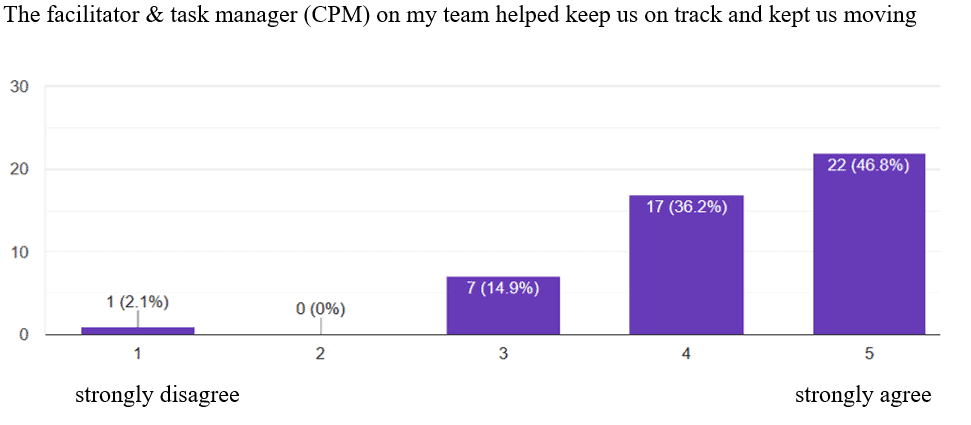Every spring, many teachers I follow on social media begin to find classroom management to be more challenging. Students get restless while anticipating breaks, and keeping behavior under wraps can be exhausting. These times, I believe, offer opportunities to try new management routines that may turn out to have far more advantages than originally thought possible. The most productive research-based practice I have discovered for my students is to group them in semi-permanent teams of about four students with assigned roles. I originally learned of the idea by using College Preparatory Mathematics (CPM) but have continued to use it with Illustrative Mathematics and Open Up Resources. These teams not only increase classroom productivity, but they also enable me to enhance social-emotional health and develop soft skills as we work.
I use a hybrid between randomized groups described in Peter Liljedahl’s Thinking Classrooms and student choice that works well for my students. I survey them to see who they want to sit with and try to have each student with one of their choices. The survey is anonymous, and it is always a bit humorous to note how many students do not want to sit with their besties, likely because they know they would be less productive. Before we get started with this arrangement, I play a brief video of what collaboration and documentation looks like in a real work environment. This is one of my favorites. Students typically love “make believe” and, in this case, they start feeling the part: a role-goal toward which to grow as they experience adulthood from a distance. I am the Chief Academic Officer.
Since team facilitators control the flow of communication, I often assign that role to English language learners or students with other types of challenges such as autism. In those situations, I include an emotionally supportive teammate to ensure needs are met and encourage them: “Rolla, have you noticed how your teammates have been responding to your leadership?” “Luan, I can see you have a way of empowering your facilitator, and the two of you are driving up productivity there!” Seating supportive teammates crosswise within a team seems to have a unifying effect as others are drawn in. When there are productivity issues within the group, I have a conversation with the facilitator and production manager. I suspect that because they understand the big picture in their roles, that usually resolves the issue.
Inevitably, students working in teams begin to realize some tend to produce answers or strategies for answers faster than others. When a student thinks of themselves as “slow,” that can be understood as “dumb.” In one or two sentences, a teacher can explain that slower can also mean deeper. Microwave vs. crockpot thinking is an analogy that recognizes strengths and weaknesses in both thinkers. “Think-pair-share” strategies can provide extra time, and facilitators can be tasked with making sure everyone has space to think. Another strategy is to make classroom materials available with the previous day’s homework so students who tend to process more slowly can read ahead. Students who get to know themselves well (have realistic self-assessment) are likely to gain confidence (Weisinger, 2015), and students who get to know others well are likely to grow in empathy.
One student on each team is a documentation manager (CPM). That role is also found in authentic work environments, and students begin to see the need for systematically showing their work in a way others can follow. I often pause teaching for extended periods of time when students employ Sketchnoting (Michael Rohde) to embed ideas in memorable ways. Documentation managers orchestrate cross-checking and editing to maximize group observations.
What Students Have Said
My classroom surveys lend support to what I am observing in terms of productivity and motivation:


In another survey, my students reported ways their teams have affected their learning:
Has working with your team increased your confidence?
We discuss things more and build off each other.
It makes me feel like I have people who can help when I need it.
It has made me a better speaker in front of the group.
They make me feel good when I know the answer and don’t make fun of me when I don’t.
Has working with a team helped you learn better?
They encourage me to get work done.
Explaining things to Chrissy helps me learn better.
It helped me gain more responsibility because I was working for people other than myself.
What have you learned besides math by working in teams?
I have learned that it is possible to have a strong bond with the people you are working with even if some weren’t friends before.
I’ve learned a lot about myself in the sense that I like to see others be happy and succeed at something.
I’ve learned how to encourage someone and not make them feel dumb when they don’t know something.
I also have learned how to teach someone something in different ways if they didn’t understand it the first way I tried to teach them.
Besides mastering mathematics, I want my students to experience, joy, curiosity, and vision in my classes. Putting production management into their hands in grown-up ways has also helped them to experience those feelings. Classroom management is much less stressful for me because the students take ownership on their own for the most part, and academic productivity stays strong through the entire year.
Citations
College Preparatory Mathematics (CPM) n.d. College Preparatory Mathematics (CPM). Retrieved December 11, 2020 from https://cpm.org/teamsupport?rq=why%20use%20study%20teams
Weisinger, H. (2015). The essence of confidence. Psychology Today. Retrieved December 9, 2020, from https://www.psychologytoday.com/us/blog/thicken-your-skin/201509/the-essence-confidence
















